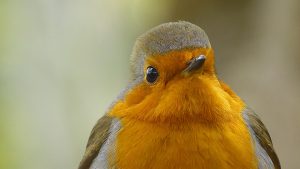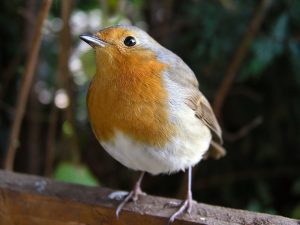Regular readers of my site might already be aware of my fondness for robins, well, one in particular, Christopher.
He is a friendly little fellow that has grown tamer over time until he is comfortable perching on my head for a moment or two.
My son asked a pertinent question the other day. Why do you always assume the robin is male, might it not be Christina and you’re giving her an identity crisis?

I decided to look into the matter to find out the difference between male and female robins, and put an end to any ambiguity!
By appearance alone, it is difficult to tell a male and female robin apart, even to the trained eye.
Although the male tends to be larger and heavier it isn’t always the case, and unless the 2 birds are alongside each other it is virtually impossible to know.
Their colouring and markings are almost identical, even though it’s widely believed that the male’s plumage is brighter.
Table of Contents
Is it possible to sex male and female robins
The most reliable way is to perform a DNA test, but that might be taking things a little too far!
There are ways to tell the difference, most of which depend on the time of year. Breeding season is the best time to identify the birds.
Courtship
Part of the mating ritual is courtship feeding whereby the male robin will feed the female. It only ever happens this way round.
Copulation follows, during which you shouldn’t need help identifying the different sexes, it is self-explanatory.

Nesting
If you spot a robin collecting materials to build or line their nest with, it will undoubtedly be a female as this is exclusively her task.
Incubation
Once a robin has laid her eggs, it is her sole responsibility to keep them warm until they’re ready to hatch. The male sits nearby, protecting his family and territory. This is a sure-fire way of recognising the sexes.
Territory
As previously mentioned, robins are fiercely territorial, so much so that a female will only enter in the breeding season. Male robins protect their territory and will fight to the death to hold it. Outside of spring and early summer, noisy and aggressive robins are most likely to be males.
Markings
American robins have more exaggerated differences between the sexes, the female is dowdier and has a distinguishable black spot at the tip of her beak.
The male has the much prettier song, and like his European counterparts, is the more aggressive of the species.
There is a subtle difference in UK robins markings but you will need to be overhead to spot it.
The peak of the female’s head forms a V-shape whilst the males is a softened U-shape.
I dare you to try and spot this at 20 feet as they snacking on your mealworms!
Final thoughts…
Statistics suggest that lone robins in gardens and parks are more likely to be male, so I am going with that. When my robin comes to visit I shall insist that it’s Christopher, and when he has his lady wife in tow unless she is obviously swollen with eggs, I shall refer to them both as Chris!

I have three Robins that regularly attend my feeders all together and have done for the past 2 years. Ive always thought of them as fiercely territorial but this seems to debunk that theory
There are areas between the core territory, which have heavy traffic (often bird feeders) which are not really defendable.
You may get multiple Robins nip through to get food here, and may well do even if it’s in the territory of one, as there’s only so much ground that can be watched by one bird, so a stealth sneak by gathers food comfortably.
Behaviours change with food abundance too. If food is scarce, you’ll see the behaviour change to highly protective of the source. If it’s abundant (well stocked feeders that become accepted as “reliable food sources”), then competition for it declines.
If another Robin tries to set up home inside the territory of another, then yes, they will fight viciously.
I have two robins that climb through a vented window, hop up on the coffee table to say good morning and then fly out. I can not figure out if they are male and female or two males. In the garden when I am sitting folded legs, one hops up on my foot or goes under my folded legs. He shows me his catch, usually a 1″ long grub by walking around in front of me. Thanks for the V vs U tip. I will see if it works.